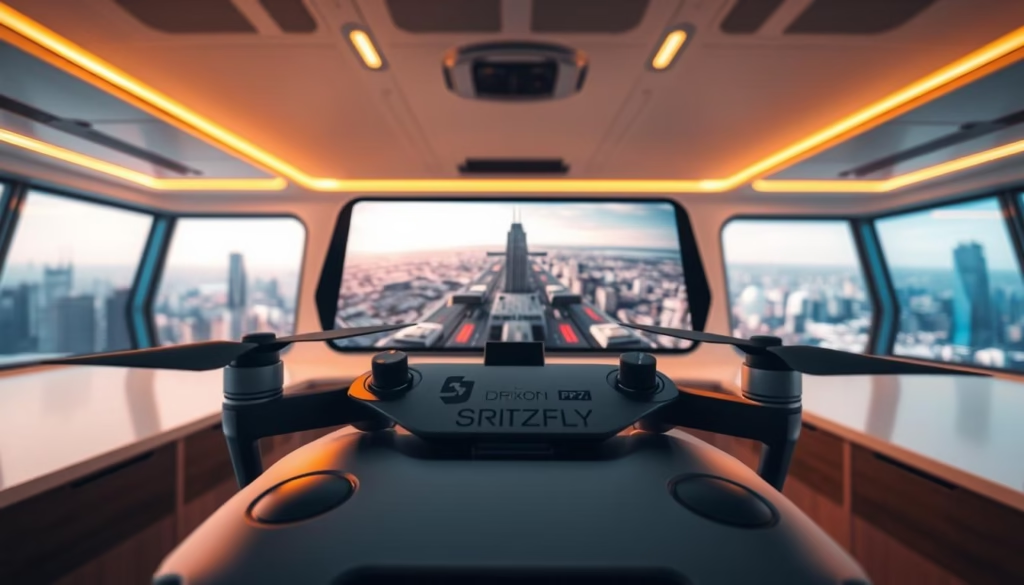The world of drone technology has seen a significant shift with the advent of simulators that allow pilots to hone their skills without the risk of damaging expensive equipment. SRIZFLY’s innovative solution brings professional-grade drone simulation to the palm of your hand, making it possible to practice flying skills anywhere, anytime.
These advanced training tools replicate real-world physics and drone behavior, enabling pilots to develop muscle memory and improve their techniques. The growing popularity of FPV drone racing and freestyle has driven the demand for accessible training solutions that work on smartphones and tablets.
With simulators like SRIZFLY, pilots can enjoy a realistic and immersive experience, preparing them for real-world flights. By combining cutting-edge technology with user-friendly interfaces, SRIZFLY is revolutionizing the way we learn to fly.
Key Takeaways
- SRIZFLY’s simulator offers a portable and accessible way to practice drone flying skills.
- Realistic physics engines accurately model drone flight characteristics.
- Ideal for both beginners and experienced pilots looking to refine their techniques.
- Enhances training efficiency and safety.
- Available for use on smartphones and tablets.
Understanding Mobile FPV Simulators
Mobile FPV simulators are changing the way we learn to fly drones, offering unprecedented accessibility and realism. These simulators provide a platform for pilots to practice and hone their skills in a virtual environment.
What Are FPV Simulators?
FPV simulators are RC flight simulators, not games, designed to mimic the experience of flying a real-life racing quadcopter. They are made to provide a realistic experience, making them an ideal tool for training. It is highly recommended to use a good physical controller, as it makes flying so much easier and more enjoyable compared to using touchscreen controls.
Benefits of Training with Mobile Simulators
Training with mobile FPV simulators offers several benefits:
- Unprecedented accessibility: Pilots can practice during lunch breaks, commutes, or whenever they have a few spare minutes.
- Consistent practice schedules: The portability factor means pilots can maintain consistent practice schedules regardless of location.
- Reduced financial barrier: Training with mobile simulators significantly reduces the financial barrier to entry.
- Experimentation without risk: Mobile platforms enable pilots to experiment with different drone configurations, flight modes, and techniques without the risk or expense of modifying actual hardware.
- Cloud synchronization: The best mobile simulators offer cloud synchronization, allowing pilots to track progress and continue their training across multiple devices seamlessly.
Here is a comparison of some key features of mobile FPV simulators:
| Feature | Mobile FPV Simulators | Desktop Simulators |
|---|---|---|
| Portability | High | Low |
| Cost | Lower | Higher |
| Realism | High | High |
Why Mobile FPV Simulators Are Essential for Drone Pilots
For drone pilots, mastering FPV flying skills is crucial, and mobile FPV simulators are essential tools for achieving this mastery. We are committed to delivering the best solutions for drone pilots, and our mobile FPV simulators are designed to provide a realistic and safe environment for pilots to hone their skills.
Practice Without Weather Constraints
You can fly (and crash!) all you want regardless of rain, wind, sleet, or snow. Mobile FPV simulators eliminate the constraints of weather, allowing for continuous practice and improvement. This means that pilots can train year-round without interruption, ensuring they are always ready for real-world flying conditions.
Risk-Free Crash Learning
Learning to fly FPV drones involves crashing, but with simulators, pilots can crash without the risk of damaging their drones. This risk-free environment is invaluable for beginners and experienced pilots alike, allowing them to test their limits and learn from their mistakes.
Cost-Effective Skill Development
The financial investment in a quality mobile FPV simulator is typically less than the cost of repairing a single significant drone crash. Here are some key benefits:
- Unlimited flight time compared to battery-limited real-world flying.
- No travel time to flying locations, making training more time-efficient.
- Beginners can test their interest in FPV flying before investing in equipment.
- Advanced pilots can test new configurations and components virtually.
| Benefits | Real-World Flying | Mobile FPV Simulators |
|---|---|---|
| Weather Constraints | Limited by weather | No weather constraints |
| Flight Time | Limited by battery life (5-10 minutes) | Unlimited flight time |
| Risk of Damage | High risk of crashes and damage | Risk-free environment |
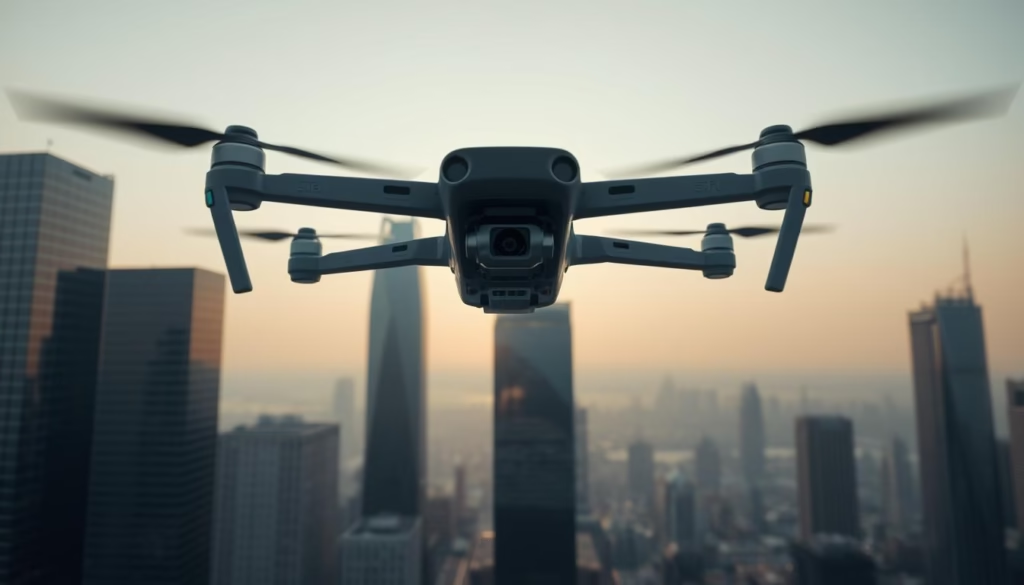
Top Mobile FPV Simulators for 2023
For drone enthusiasts, 2023 is an exciting year, with numerous top-notch mobile FPV simulators available. As the demand for drone training and practice grows, these simulators offer a realistic and immersive experience, helping pilots improve their skills. In this section, we will explore four of the best mobile FPV simulators available this year.
FPV Freerider
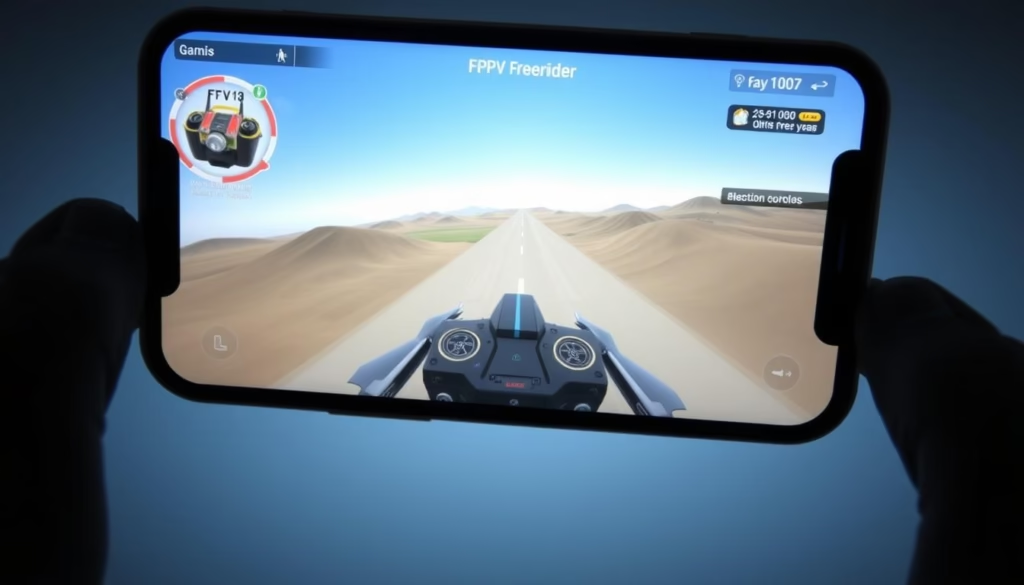
Overview
FPV Freerider is a popular mobile FPV simulator known for its realistic physics engine and challenging tracks.
Pros
Realistic physics, challenging tracks, and a strong community of users.
Cons
Some users may find the controls difficult to master, and there is a limited number of tracks available.
Features
FPV Freerider features a realistic physics engine, various tracks, and different drone customization options.
DJI Flight Simulator
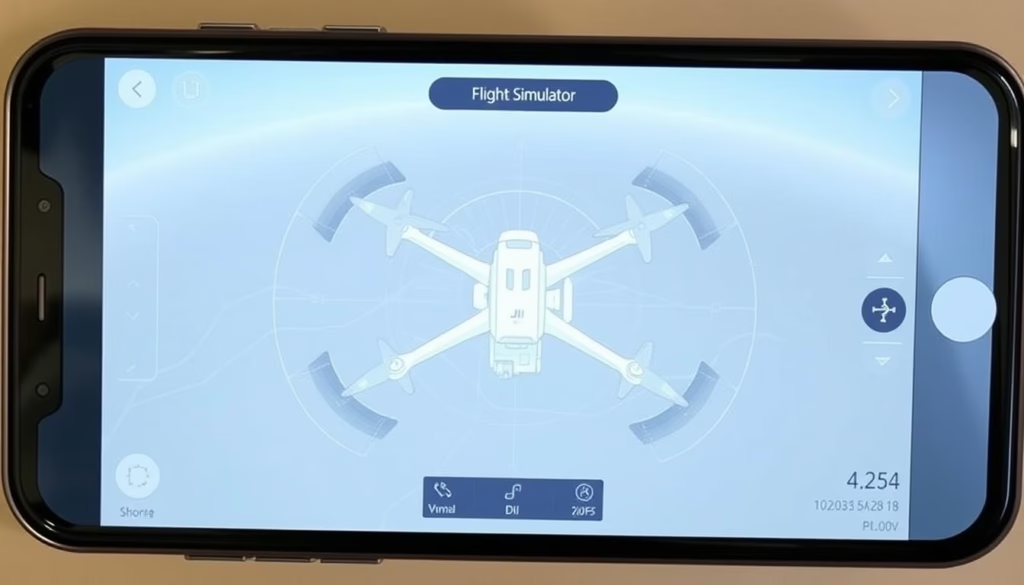
Overview
DJI Flight Simulator is a robust simulator that offers a realistic drone experience, with a vast library of tracks and multiplayer functionality.
Pros
Extensive track library, multiplayer functionality, and comprehensive drone customization.
Cons
Some users may experience some lag, and the simulator may be resource-intensive.
Features
Key features include an extensive track library featuring replicas of famous real-world drone racing courses, multiplayer functionality for racing against other pilots online, comprehensive drone customization, detailed lap timing, and regular content updates with new tracks and environments.
Liftoff: FPV Drone Racing
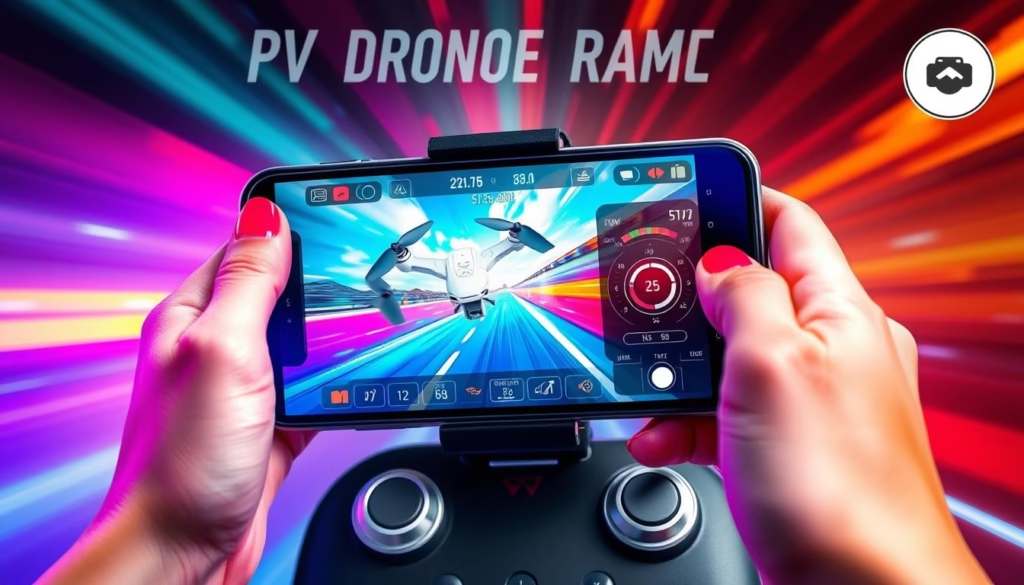
Overview
Liftoff: FPV Drone Racing is a popular simulator that offers a realistic FPV experience, with a variety of tracks and drones.
Pros
Realistic FPV experience, various tracks, and a wide range of drones.
Cons
Some users may find the graphics not as refined as other simulators.
Features
Liftoff: FPV Drone Racing features realistic FPV, various tracks, and different drone models.
Velocidrone
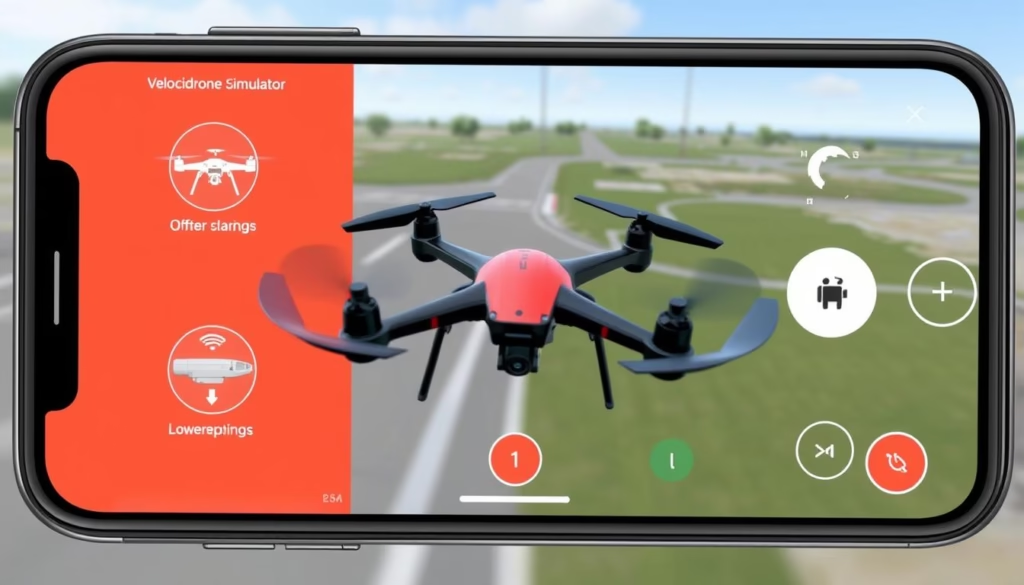
Overview
Velocidrone is a high-performance FPV simulator that offers realistic physics and a vast track library.
Pros
Realistic physics, vast track library, and a strong focus on realism.
Cons
Some users may find the simulator too challenging, and there may be a steep learning curve.
Features
Velocidrone features realistic physics, a vast track library, and a strong focus on realism.
Key Features to Look for in a Mobile FPV Simulator
When selecting a mobile FPV simulator, several key features must be considered to ensure an optimal training experience. The effectiveness of a simulator is determined by how well it replicates real-world flying conditions and how it adapts to the user’s needs.
Physics Engine Accuracy
A simulator’s physics engine accuracy is crucial for realistic flight dynamics. It should accurately model the behavior of drones, including factors like weight, aerodynamics, and the effects of weather conditions. A precise physics engine helps pilots develop a realistic feel for flying, enhancing their skills.
Controller Compatibility
Controller compatibility is another vital feature. The simulator should support a variety of controllers, including Bluetooth controllers and USB OTG compatible RC controllers. This flexibility allows pilots to use their preferred controller, enhancing the training experience.
Graphics Quality vs. Performance
The balance between graphics quality and performance is critical. High-quality graphics enhance the realism of the simulation, but they can also impact performance. For optimal performance, it’s essential to adjust graphics settings and resolution. For instance, selecting low resolution and low graphics quality on the main menu can improve performance. Additionally, activating “Performance Mode” or a similar setting on your device can further enhance the simulator’s performance.
| Graphics Setting | Performance Impact | Visual Quality |
|---|---|---|
| Low | High | Low |
| Medium | Medium | Medium |
| High | Low | High |
Track and Environment Variety
A diverse range of tracks and environments is essential for comprehensive training. Look for simulators that offer both technical racing tracks and open freestyle areas. The best simulators include environments with varying levels of visual complexity, from simple obstacle courses to detailed urban settings. Additionally, environment variety should include different lighting conditions to simulate flying in various real-world scenarios.
By considering these key features, you can choose a mobile FPV simulator that meets your training needs and enhances your drone flying skills.
Controller Options for Mobile FPV Simulators
When it comes to mobile FPV simulators, the choice of controller can significantly impact the training experience. Pilots have a range of options to choose from, depending on their preferences and the type of equipment they use.
Touchscreen Controls
Many mobile FPV simulators offer touchscreen controls, allowing pilots to navigate and control their drones directly on their mobile device’s screen. This option is convenient for those who don’t have a dedicated RC controller.
Bluetooth Controllers
Bluetooth controllers provide another flexible option, enabling pilots to use gamepads or other Bluetooth-enabled devices to control their drones. This is particularly useful for those who prefer a more traditional gaming-style experience.
USB OTG Compatible RC Controllers
For a more authentic experience, many pilots prefer using their actual RC controllers with mobile FPV simulators via USB OTG (On-The-Go) compatibility. This allows for a more realistic training experience, as pilots can use the same controller they use for real flights. Controllers like FrSKY Taranis, Spektrum, and DJI FPV are supported by many simulators.
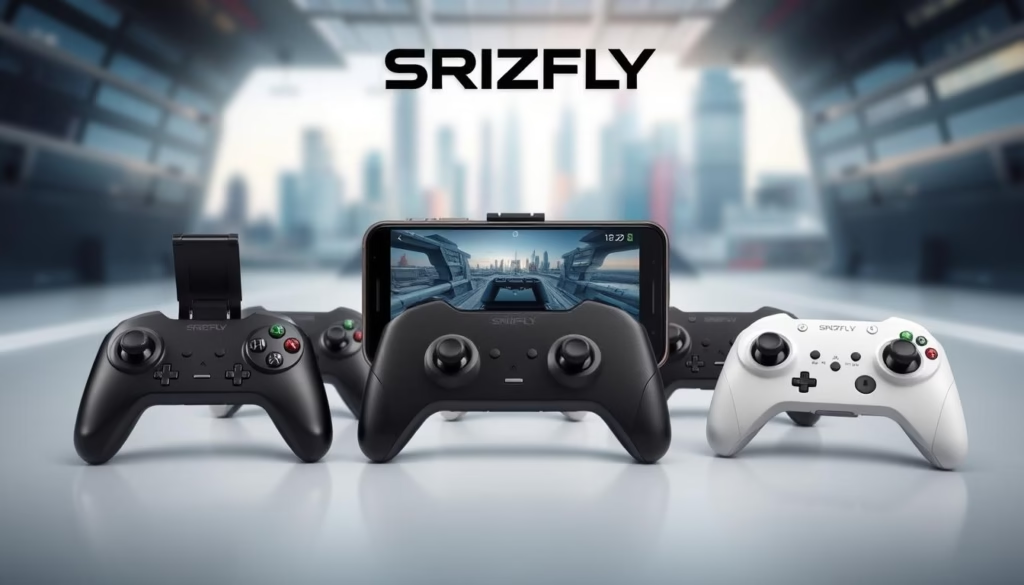
DJI and Other Brand Compatibility
DJI remote controllers, including those for the DJI FPV system, can connect to many simulators through USB, offering DJI pilots authentic training with their familiar equipment. Many simulators also support brand-specific features and a wide range of other RC controllers from brands like Futaba, Graupner, and more, ensuring compatibility and a realistic training experience.
Flight Modes and Training Techniques
Precise flying requires a thorough understanding of flight modes and techniques. As a drone pilot, mastering different modes and training methods is crucial for enhancing your skills.
Self-Leveling vs. Acro Mode
Understanding the difference between self-leveling and Acro mode is vital for FPV flying. Self-leveling mode helps beginners maintain a stable flight, while Acro mode provides more freedom for advanced maneuvers. As you progress, you’ll rely more on Acro mode for complex flight patterns.
First Person View (FPV) vs. Line of Sight (LOS)
FPV flying offers an immersive experience, allowing pilots to navigate through complex environments. In contrast, LOS flying keeps the drone in the pilot’s line of sight, suitable for beginners or specific applications. Understanding both modes enhances your overall flying abilities.
Progressive Skill Development Path
A well-structured training progression is key to mastering drone skills. The training path includes:
- Basic training: Start with self-leveling mode, focusing on hovering and basic forward flight.
- Intermediate skills: Practice coordinated turns, figure-8 patterns, and precision flying.
- Advanced training: Incorporate racing lines, power management, and technical maneuvers.
- Expert-level practice: Combine technical elements into flowing sequences, developing situational awareness.
Effective training follows a structured progression, from basic to advanced skills. Here is a summary of the progression in a tabular form:
| Skill Level | Training Focus | Key Techniques |
|---|---|---|
| Beginner | Self-leveling mode | Hovering, basic forward flight |
| Intermediate | Coordinated turns and precision | Figure-8 patterns, precision flying through gates |
| Advanced | Racing lines and technical maneuvers | Power management, power loops, split-S turns |
| Expert | Flowing sequences and situational awareness | Combining technical elements, competitive racing |
As you progress through these stages, you’ll improve your FPV skills, moving from real-life simulations to more complex mode operations. The key is consistent practice and a well-planned training regimen.
SRIZFLY Mobile FPV Simulator Features
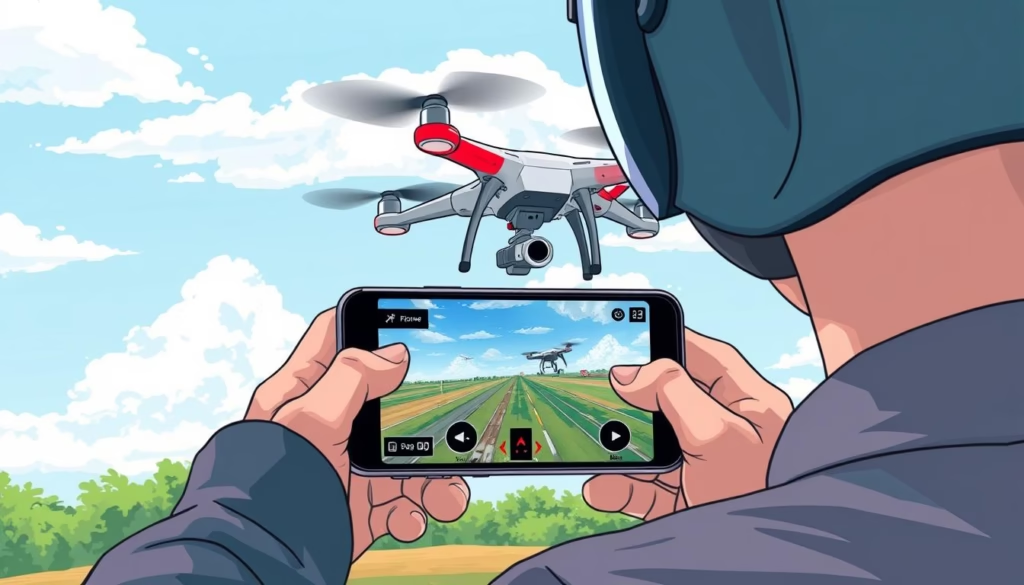
Discover the advanced features of SRIZFLY’s Mobile FPV Simulator, designed to enhance your drone flying experience. Our simulator is equipped with cutting-edge technology to provide a realistic and immersive training environment.
10-Day Free Trial Offering
We offer a 10-day free trial, allowing you to explore the full potential of our simulator without any initial commitment. This trial period gives you the opportunity to experience the advanced features and decide if SRIZFLY is right for you.
Advanced Physics Engine
Our simulator boasts an advanced physics engine that accurately simulates the behavior of drones in various conditions. This includes realistic graphics and physics-based interactions, ensuring a lifelike training experience. The engine takes into account factors such as wind resistance, gravity, and aerodynamics.
Customization Options
SRIZFLY offers unprecedented customization depth, allowing pilots to adjust virtually every aspect of their virtual drone’s performance. This includes comprehensive PID controller tuning, motor response curves, and weight distribution settings. You can also customize visual aspects such as camera settings, field of view, distortion, and simulated analog noise for authentic FPV visuals. Furthermore, environment customization includes time of day, lighting conditions, and weather effects that impact both visuals and flight physics.
With SRIZFLY, you have the flexibility to tailor your training experience to match your exact preferences and needs, making it an ideal tool for both beginners and experienced pilots.
How Mobile FPV Simulators Translate to Real-World Flying
As we explore the capabilities of mobile FPV simulators, it is crucial to understand how they translate to real-world flying. Mobile FPV simulators have become an essential tool for drone pilots, providing a realistic and risk-free environment to practice and hone their skills.
Muscle Memory Development
One of the key benefits of using mobile FPV simulators is the development of muscle memory. By practicing with a simulator, pilots can develop the necessary muscle memory to navigate complex drone movements, such as those required in FPV drone racing. Regular practice with a simulator can improve a pilot’s reaction time and overall flying skills, making them more proficient in real-world flying.
Situational Awareness Training
Mobile FPV simulators also provide situational awareness training, which is critical for real-world flying. Pilots can practice navigating through different environments and scenarios, such as obstacle courses or simulated races, which helps to improve their spatial awareness and decision-making skills. Situational awareness is essential for avoiding collisions and navigating complex flying environments.
Limitations of Simulation vs. Reality
While mobile FPV simulators are remarkably accurate, there are some limitations to consider. For instance:
- Environmental factors like variable wind gusts, thermal air movements, and ground effect near surfaces are simplified in most simulators.
- The consequences of mistakes lack the emotional impact of risking real equipment, potentially leading to more aggressive flying styles in simulation.
- Visual limitations of screens versus actual FPV goggles can affect depth perception and spatial awareness differently.
Despite these limitations, mobile FPV simulators remain a valuable tool for drone pilots, providing a realistic and effective way to improve their skills. By understanding the strengths and limitations of simulators, pilots can maximize their training and improve their real-world flying abilities.
Conclusion: Elevating Your Drone Skills Through Mobile Practice
As we conclude our exploration of mobile FPV simulators, it’s clear that these tools are revolutionizing the way we develop drone skills. Mobile FPV simulators have transformed drone skill development, making professional-level training accessible anywhere and anytime.
The financial investment in quality simulator technology pays dividends through reduced crash repairs, accelerated skill development, and more efficient use of actual flying time. SRIZFLY’s mobile simulator stands out with its industry-leading physics accuracy, comprehensive customization settings, and risk-free 10-day trial.
Consistent FPV simulator practice creates a virtuous cycle of improvement, where skills developed virtually enhance flying real-world performance, which in turn informs more effective FPV drone simulator sessions. As drone technology continues to advance, simulators will play an increasingly important role in pilot training, competition preparation, and the growth of the FPV community as a whole.
We encourage all pilots, from complete beginners to seasoned professionals, to incorporate mobile simulation into their regular practice routine to experience the remarkable skill acceleration it provides. Take advantage of SRIZFLY’s free trial today to experience the most accurate and comprehensive mobile FPV drone simulator available, with no risk or obligation.
FAQ
What are the benefits of using a drone simulator for training?
Using a drone simulator for training offers several benefits, including reduced risk of damage to your drone, cost-effective skill development, and the ability to practice without weather constraints.
Are drone simulators compatible with different types of drone controllers?
Yes, many drone simulators are compatible with various drone controllers, including Bluetooth controllers, USB OTG compatible RC controllers, and DJI controllers.
Can I use a drone simulator to improve my drone racing skills?
Absolutely, drone simulators like FPV Freerider, Liftoff: FPV Drone Racing, and Velocidrone are designed to help you improve your drone racing skills by providing realistic tracks and environments.
How do I choose the right drone simulator for my needs?
When choosing a drone simulator, consider factors such as physics engine accuracy, controller compatibility, graphics quality, and track variety to ensure it meets your training requirements.
Is SRIZFLY's mobile FPV simulator suitable for beginners?
Yes, SRIZFLY’s mobile FPV simulator is designed to be user-friendly and offers a progressive skill development path, making it suitable for beginners and experienced pilots alike.
What is the advantage of SRIZFLY's 10-day free trial?
SRIZFLY’s 10-day free trial allows you to test the simulator’s features and performance risk-free, ensuring it meets your needs before committing to a purchase.
How do drone simulators help with real-world flying?
Drone simulators help develop muscle memory, improve situational awareness, and provide a realistic flying experience, translating to improved performance in real-world flying.

